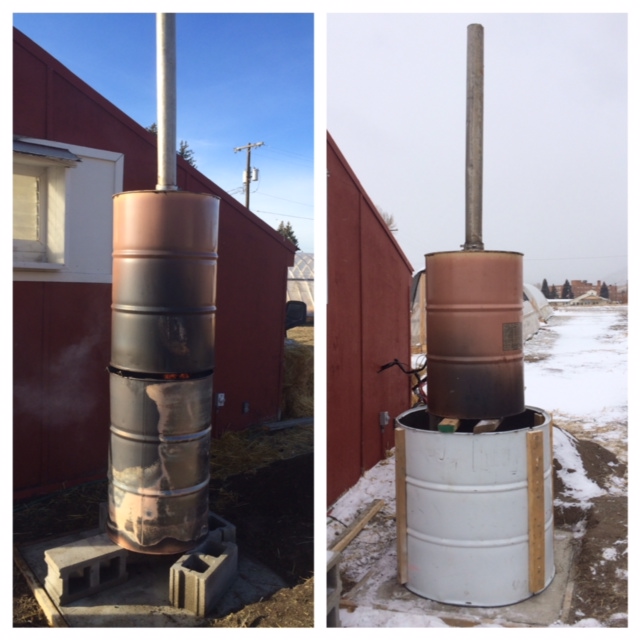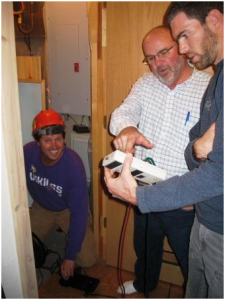Read about Mike’s experience at the AERO conference and an update on his Biochar Kiln:

Biodigesters, off grid photovoltaic systems, passive solar designs, organic apple orchards? Okay, you are speaking my language. Three Energy Corps members, one Energy Corps alumni and myself were fortunate enough to attend AERO’s (Alternative Renewable Energy Organization) 39th Annual Meeting in Hamilton, MT in late October of 2013. This meeting was such a great balance of education and entertainment. Workshops were held on various subjects related to conservation, agriculture, and energy. These included: on-farm biodiesel, homestead organics, photovoltaic systems with battery backups, on-farm food safety, Farm to Institution with Montana Food Corps, climate conservation planning, harmful effects of fracking, beekeeping, tree grafting, and finally the dangers of the industrialized food system with keynote speaker Wenonah Hauter, author of Foodopoly. Overall, the AERO meeting was a great mixture of environmental stewards with backgrounds in energy and agriculture. I was glad to meet so many like-minded individuals, and enjoyed hearing about everyone’s personal experiences and interests.
With limited time and so many options, I attended the workshops with subjects in which I knew the LEAST about. Among the various workshops I attended my favorite was beekeeping, with Jacob Wustner. With the industrialized food system there is a huge disconnect between the farmer and consumer. I think it is very important to know where our food came from and “know our farmer”. I had never met a beekeeper before, so it was great to learn about how honey was collected and processed. Because beekeeping has been a family tradition for many years, Jacob certainly possessed expertise on the subject, but he has now broken off and started his own beekeeping operation. He has taken it a step further to use sustainable beekeeping practices only treating their bees with organic treatments to prevent parasitic presence and disease. Lastly, in this workshop I gained a new perspective on different roles of plants in nature, specifically, knapweed. Until this workshop I had always considered knapweed harmful, as it can have negative effects on certain crops. Although harmful to some plants, bees love it. We were able to sample two different kinds of honey and the knapweed honey most definitely had a unique flavor. I am not saying that we should allow knapweed to grow wildly everywhere, but I do think that it is important to recognize every plants niche in nature.
Taking shape
Here at NCAT I have continued working on the biochar kiln. To start, I needed to lay a level concrete slab. When laying a concrete slab it is important to lay gravel at the very bottom to allow water to flow freely underneath, otherwise the slab may move and buckle, in our case we were able to use glass cullet produced from a pulverizer. I placed the kiln beside the greenhouse with hopes to channel excess heat into the greenhouse for supplemental heat. I started with a basic two barrel design. This design features one barrel stacked on top of another, with angle iron in between to act as spacers to allow for secondary air. The bottom barrel is elevated on CMU’s (concrete masonry units) with slits cut into the bottom to allow for primary airflow; this barrel is where the fire is created. A hole is cut into the top of the barrel a couple inches away from the perimeter; this portion acts as the “concentrator ring”. To create biochar an oxygen limited chamber (retort) is necessary. In my case, I was able to find what is called a “Cornelius keg” at the local salvage yard. The angle iron used to create the space between the two 55 gallon barrels is also used to elevate the retort right above the fire. Around the Cornelius keg is the upper 55 gallon barrel. This barrel sits on top of the spacers and has the bottom completely cut out to allow heat to travel in an upward, and also has a chimney placed on top to create the stack effect.


Time to burn! So far, I have had two burns, with some success and some failure. The biomass refers to material placed inside the Cornelius keg to be turned into biochar. With the first burn I used medium sized sticks both for the biomass and the firewood. The result was some of the biomass became charred (the smaller pieces); bigger pieces did not char, likely because the fire did not last long enough, or did not get hot enough. So, in my second attempt I used smaller pieces of wood chips for the biomass, and very thick pieces for the firewood in hopes to have a longer burn. With this burn an abnormal amount of smoke began about 20 minutes in.
For a cleaner burn, I plan to incorporate the rocket stove in the bottom portion of this two barrel design. The rocket stove portion features a “J tube”, or “L tube” chamber that is quite literately shaped like a capital J or L, this chamber must have the same sized diameter from the beginning to end, and must be made of high refractory material such as iron, or firebrick. This J-tube or L-tube must be highly insulated. The purpose of the outside barrel will be to hold in the insulation. If iron is used, the 55 gallon barrel will be large enough to contain the insulation, which will most likely be perlite. If firebricks are used, this portion of the rocket stove will be much bulkier, and thus a bigger barrel may have to be used. In this case I have created a bigger barrel by cutting and shaping two smaller barrels to make a bigger diameter. These pieces are bolted together with wooden braces, because this barrel is being used to hold in insulation, and is not seeing the brunt of the burn, the wooden braces should not be a problem.
 Michael Daniel has a bachelor’s degree in appropriate technology from Appalachian State University in Boone, NC. He has experience in building greenhouses and working at a wind power demonstration site on Beech Mountain, NC. During his Energy Corps term, Mike will develop infrastructure and growing systems on a demonstration farm in addition to providing renewable energy education to local schools. His work will also consist of researching, designing, and installing of renewable energy systems to service green houses.
Michael Daniel has a bachelor’s degree in appropriate technology from Appalachian State University in Boone, NC. He has experience in building greenhouses and working at a wind power demonstration site on Beech Mountain, NC. During his Energy Corps term, Mike will develop infrastructure and growing systems on a demonstration farm in addition to providing renewable energy education to local schools. His work will also consist of researching, designing, and installing of renewable energy systems to service green houses.








